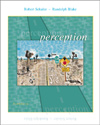 |  Perception, 4/e Robert Sekuler,
Brandeis University
Randolph Blake,
Vanderbilt University
Spatial Vision and Pattern Perception
Chapter Outline- WHAT DEFINES AN OBJECT?
- WHAT DEFINES "FORM?"
- WHAT ARE THE COMPONENTS OF FORM?
- A LOCAL ANALYSIS: DIFFERENCES BETWEEN NEIGHBORS
- GRATINGS AS TOOLS FOR EXPLORING FORM PERCEPTION
- What Are Gratings?
- Spatial frequency
- Contrast
- Orientation
- Spatial phase
- Using Gratings to Measure Performance
- THE CONTRAST SENSITIVITY FUNCTION AS A WINDOW OF VISIBILITY
- The Human Contrast Sensitivity Function
- CSFs of Other Species
- Age and the CSF
- The Structural Basis of the CSF
- FORM DISCRIMINATION
- Metamers
- FORM DEFINED BY TEXTURE DIFFERENCES
- PUTTING IT ALL TOGETHER: A GLOBAL ANALYSIS
- PUTTING THE PARTS TOGETHER: THE GESTALT PRINCIPLES
- Gestalt principles of organization
- Why do the Gestalt principles work at all?
- Global structure and symmetry
|
|



 2002 McGraw-Hill Higher Education
2002 McGraw-Hill Higher Education